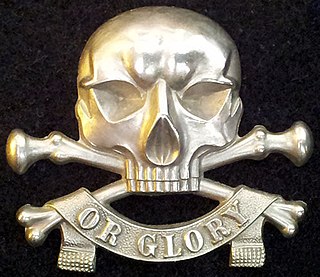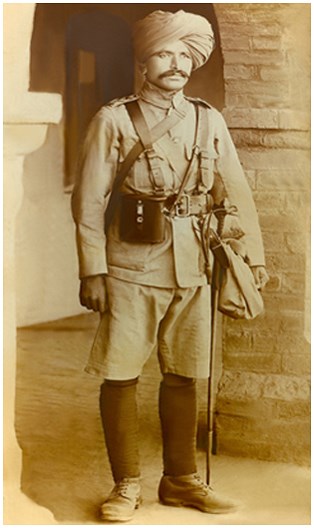
The 17th Lancers (Duke of Cambridge's Own) was a cavalry regiment of the British Army, raised in 1759 and notable for its participation in the Charge of the Light Brigade during the Crimean War. The regiment was amalgamated with the 21st Lancers to form the 17th/21st Lancers in 1922.

The North-West Frontier was a region of the British Indian Empire. It remains the western frontier of present-day Pakistan, extending from the Pamir Knot in the north to the Koh-i-Malik Siah in the west, and separating the modern Pakistani frontier regions of North-West Frontier Province, Federally Administered Tribal Areas and Balochistan from neighbouring Afghanistan in the west. The borderline between is officially known as the Durand Line and divides Pashtun inhabitants of these provinces from Pashtuns in eastern Afghanistan.

General Sir James Hope Grant, GCB was a British Army officer. He served in the First Opium War, First Anglo-Sikh War, Indian Rebellion of 1857, and Second Opium War.

The 101st Grenadiers was a regiment of the British Indian Army.

The 9th Queen's Royal Lancers was a cavalry regiment of the British Army, first raised in 1715. It saw service for three centuries, including the First and Second World Wars. The regiment survived the immediate post-war reduction in forces, but was amalgamated with the 12th Royal Lancers to form the 9th/12th Royal Lancers in 1960.
Lieutenant General Sir Lewis Macclesfield Heath, was an officer in the British Indian Army during the early to mid-twentieth century.

The Indian Army, also called the British Indian Army, was involved in World War I as part of the British Empire. Over one million Indian troops served overseas, of whom 62,000 died and another 67,000 were wounded. In total at least 74,187 Indian soldiers died during the war.
Iraqforce was a British and Commonwealth formation that came together in the Kingdom of Iraq. The formation fought in the Middle East during World War II.

Lieutenant General Sir Reginald Arthur Savory was a British Indian Army officer who served during both World War I and World War II.

The 7th (Meerut) Division was an infantry division of the British Indian Army that saw active service during World War I.

The Guides Cavalry (Frontier Force) is an armoured regiment of the Pakistan Army which was raised in 1846 as The Corps of Guides. During more than a hundred and fifty years of military service, the regiment has earned the reputation of one of the most renowned military units in the world.

The Central India Horse was a regular cavalry regiment of the British Indian Army and is presently part of the Indian Army Armoured Corps.

The Bombay Army was the army of the Bombay Presidency, one of the three presidencies of British India.

The Madras Army was the army of the Presidency of Madras, one of the three presidencies of British India within the British Empire.
Brigadier-General Philip John Miles, CB, CMG, FRGS, was a British officer of the Indian Army during the late nineteenth and early twentieth century. After an early career serving on the North-West Frontier and in Central Asia, he rose to command brigades during the First World War and the Third Anglo-Afghan War.
Major-General Sir Digby Inglis Shuttleworth KCIE CB CBE DSO was a senior British Indian Army officer.

Operations against the Marri and Khetran tribes was the British name for a punitive expedition carried out against the Marri and Khetran tribes of Balochistan, British India between February and April 1918. The Marri rose against the British authorities around 18 February, encouraged by rumours that the British were short of manpower due to the First World War. British attempts at conciliation were repulsed and, on 20 February, a major attack was made by 1,000 – 3,000 Marri upon the British post at Gumbaz. This attack was repulsed by a much smaller British force that inflicted heavy losses upon the Marri. A subsequent withdrawal of British forces from Kohlu and its occupation by the Marri led the Khetrans to join the rising. The town of Barkhan was occupied by Marri-Khetran forces and raids were made upon villages in the Sibi and Loralai districts; railways in the area were also attacked.
Lieutenant-General Sir Michael White KCB was a British Army officer. The son of a major in the 27th Dragoons, he received a commission in the same regiment in 1804. White served in India on the Sikh frontier; during the 1817 Siege of Hathras; the 1817-18 Third Anglo-Maratha War and the 1825-26 Siege of Bharatpur. From 1839 he commanded the 3rd Light Dragoons and led them in the 1842 invasion of Afghanistan for which he was appointed a Companion of the Order of the Bath.

Raghbir Singh Pathania, was an Indian Lieutenant Colonel who was the primary commander of the 2nd Jammu and Kashmir Rifles during the Battle of Jassin, in which he was killed while defending a garrison of 4 Indian Brigades.













